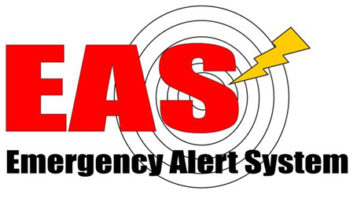 The Federal Communications Commission has just asked a big question: Should the legacy, audio-based Emergency Alert System architecture be redesigned?
The Federal Communications Commission has just asked a big question: Should the legacy, audio-based Emergency Alert System architecture be redesigned?
That is one of a bunch of questions that the FCC has asked in a new notice of inquiry about EAS. As Chairwoman Jessica Rosenworcel put it, “We’re looking for all the good ideas here, both big and small, because we know first-hand they can make a difference.”
The commission took several steps regarding alerting at Tuesday’s meeting, and this big question came toward the end.
First, it issued a notice of proposed rulemaking that sets out proposed changes to improve visual messages that appear on television during nationwide tests.
“When EAS alerts are displayed on the screen, they have both an audio component and a visual component,” Rosenworcel wrote in a statement. “In other words, they feature both a recorded message and a text crawl. But because of the legacy television architecture of EAS, the audio component may not always match the visual text. This can mean that in some circumstances, less information may be conveyed to either those individuals who have access only to the visual component or to those who have access only to the audio component. It can cause real confusion.”
This is especially true for those with disabilities, she said.
[Related: “FCC Contemplates ‘Persistent’ EAS Alerts”]
“For starters, we propose to improve the script for visual text during nationwide tests of the legacy system. We also propose changes to our rules that would bring similar clarity to nationwide tests using the newer, internet-based common alerting protocol, or CAP.”
Also, because there is greater ability to include enhanced text with CAP alerts, the FCC proposes to require broadcasters to check to see if a CAP version of an alert is available when they receive an emergency alert over the legacy system. “Finally, we ask what additional steps can be taken to rethink the architecture of EAS and improve the functionality of the system as a whole.”
In addition to that NPRM, it opened a notice of inquiry asking about more dramatic changes to legacy EAS.
A draft version of these actions was published prior to the meeting, you can read that here; the long list of questions starts in paragraph 24 on page 13. It includes questions like “Is there a more functional compression or modulation scheme that could replace AFSK,” and “Can we take advantage of digital transmission standards like ATSC 3.0 and HDR standards to improve EAS’s capabilities” and “Would it make sense to use legacy EAS only for the EAN (i.e., national emergencies) and NPT (to test the legacy system’s performance in delivering the EAN), but require use of CAP for all other alerts?”
And then the NOI concludes with that big question we led with above.
The FCC wrote, “The legacy EAS is audio-based, and daisy chain-based, because a relatively small number of hardened, full-power AM radio stations can reach 90 percent of the continental U.S. population, potentially allowing the president to communicate to the public during a national emergency. The system is centered on the EAS Protocol because it allows for automated EAS operation on the EAS Participants’ parts, and it is the same protocol used for NWS alerts broadcast over the National Weather Radio system. When the commission adopted the CAP EAS rules in 2012, it kept the legacy EAS because of its resiliency in the face of a national emergency, and because there was no fully CAP-centric system in place — where EAS messages are inputted and outputted in CAP format rather than the EAS Protocol format — to replace it.
“Do these factors remain as true and relevant today?” the FCC wants to know.
“Can the EAS architecture be redesigned to achieve the resiliency and automation provided by the legacy EAS (including delivery of ‘live’ audio), but with the functionalities provided with CAP — such as a system where the alert is still delivered over-the-air using daisy chain distribution, but the alert is formatted in CAP, with ‘live’ audio enabled by an instruction in the CAP contents?”
It wants to know what burdens and costs that would raise, whether downstream processing would systems be affected, whether consumer and enterprise emergency radios would be affected, whether NWS alerts would be affected and much more.
Comments will be taken in PS Docket No. 15-94, and we’ll report on filing deadlines when we have them.
The post FCC Asks: Should Legacy EAS Be Redesigned Altogether? appeared first on Radio World.
